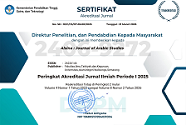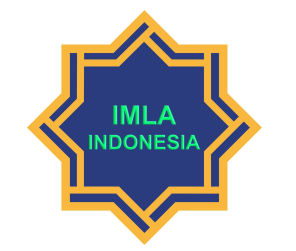Implementasi Penilaian Non-Tes Mahārah Kalām: Studi Kasus Multisitus di Perguruan Tinggi Yogyakarta
DOI:
https://doi.org/10.21580/alsina.7.1.26108Keywords:
Arabic speaking skills, authentic assessment, maharah kalam, non-test assessmentAbstract
Non-test assessment is an evaluation method that focuses on students’ processes and performance in real contexts without relying on written examinations. This study aims to analyze the implementation of non-test assessment in the mahārah kalām (speaking skills) course at three higher education institutions: STAI Masjid Syuhada (STAIMS), Universitas Muhammadiyah Yogyakarta (UMY), and UIN Sunan Kalijaga Yogyakarta (UIN Suka). Employing a multi-site case study with a descriptive qualitative approach, data were collected through in-depth interviews, participatory classroom observations, and analysis of assessment documents and student outputs. The findings reveal diverse strategies tailored to each institution’s characteristics. STAIMS applies a project-based assessment by producing Arabic-language vlogs to enhance communication, creativity, and digital literacy. UMY adopts a process-based approach through simulations and role-play, enabling gradual skill development with direct feedback. UIN Suka relies on intensive muḥādathah and khiṭābah minbarīyah practices to refine fluency and formal rhetoric. All three models are grounded in authentic and performance-based assessment principles, evaluating competence contextually, applicatively, and holistically. This study underscores that diverse approaches can complement one another in developing Arabic speaking proficiency, offering comparative insights into locally adapted pedagogical innovations aligned with learners’ needs and learning contexts.
Downloads
References
Abicandra, Muhammad Nidom Hamami. “Application of Authentic Assessment in Arabic Language Teaching in the Program of Studying the Arabic Language at the Idrisi Islamic Boarding School for Boys, Jember.” Journal of Arabic Language Teaching 2, no. 1 (2022): 1–16. https://doi.org/10.35719/arkhas.v2i1.1267.
Al-Ghezi, Ragheb et al. “Automatic Speaking Assessment of Spontaneous L2 Finnish and Swedish.” Language Assessment Quarterly 20, no. 4–5 (2023): 421–44. https://doi.org/10.1080/15434303.2023.2292265.
Angelina, Elen Nokalia. The Effect of Project-Based Learning in Improving Students’ Speaking Ability (Undergraduate Thesis). Banda Aceh: Ar-Raniry State Islamic University, 2020. https://repository.ar-raniry.ac.id/id/eprint/13865/.
Baartman, Liesbeth K.J. et al. “Evaluating Assessment Quality in Competence-Based Education: A Qualitative Comparison of Two Frameworks.” Educational Research Review 2, no. 2 (2007): 114–29. https://doi.org/10.1016/j.edurev.2007.06.001.
Baroroh, R. Umi, and Nafisatun Nisa. “Non-Test Assessment Innovation Performance for Maharah Kalam Through Youtube in the Pandemic Era.” Ijaz Arabi Journal of Arabic Learning 5, no. 1 (2022): 222–33. https://doi.org/10.18860/ijazarabi.v5i1.14789.
Bijani, Houman et al. “Investigating the Effect of Classroom-Based Feedback on Speaking Assessment: A Multifaceted Rasch Analysis.” Language Testing in Asia 12, no. 1 (2022): 26. https://doi.org/10.1186/s40468-022-00176-3.
Burton, John Dylan. “‘How Scripted Is This Going to Be?’ Raters’ Views of Authenticity in Speaking-Performance Tests.” Language Assessment Quarterly 17, no. 3 (2020): 244–61. https://doi.org/10.1080/15434303.2020.1754829.
Canale, Michael, and Merrill Swain. “Theoretical Bases of Communicative Approaches to Second Language Teaching and Testing.” Applied Linguistics I, no. 1 (1980): 1–47. https://doi.org/10.1093/applin/I.1.1.
Che Mat, Azman et al. “An Authentic Learning Environment Based on Video Project among Arabic Learners.” International Journal of Applied Linguistics and English Literature 6, no. 4 (2017): 143–48. https://doi.org/10.7575/aiac.ijalel.v.6n.4p.143.
Chong, Sin Wang, and Hayo Reinders. “Introduction: Learning-Oriented Language Assessment—Insights for Evidence-Based Practices.” In Innovation in Learning-Oriented Language Assessment, edited by Sin Wang Chong and Hayo Reinders, 1–11. Cham: Palgrave Macmillan, 2023. https://doi.org/10.1007/978-3-031-18950-0_1.
Du, Jinming, and Ben Kei Daniel. “Transforming Language Education: A Systematic Review of AI-Powered Chatbots for English as a Foreign Language Speaking Practice.” Computers and Education: Artificial Intelligence 6 (2024): 100230. https://doi.org/10.1016/j.caeai.2024.100230.
Fathi, Jalil et al. “Improving EFL Learners’ Speaking Skills and Willingness to Communicate via Artificial Intelligence-Mediated Interactions.” System 121 (2024): 103254. https://doi.org/10.1016/j.system.2024.103254.
Handley, Zoe L., and Haiping Wang. “What Do the Measures of Utterance Fluency Employed in Automatic Speech Evaluation (ASE) Tell Us About Oral Proficiency?” Language Assessment Quarterly 21, no. 1 (2024): 3–32. https://doi.org/10.1080/15434303.2023.2283839.
Ikhrom, Ikhrom. “The Impact of Learning Assessment Emergency on the Education Quality.” Lentera Pendidikan : Jurnal Ilmu Tarbiyah Dan Keguruan 26, no. 1 (2023): 31–44. https://doi.org/10.24252/lp.2023v26n1i4.
Isbell, Daniel R. et al. “Using the ACTFL OPIc to Assess Proficiency and Monitor Progress in a Tertiary Foreign Languages Program.” Language Testing 36, no. 3 (2019): 439–65. https://doi.org/10.1177/0265532218798139.
Loomis, Summer. “Using Speaking Test Data to Define the Advanced Proficiency Level for L2 Arabic Speakers.” Foreign Language Annals 48, no. 4 (December 2015): 604–17. https://doi.org/10.1111/flan.12167.
Mabruri, Mabruri et al. “Implementasi Penilaian Non-Tes Dalam Perkuliahan Di Prodi Pendidikan Bahasa Arab Se-Yogyakarta.” Jurnal Ihtimam 7, no. 2 (2024): 182–98. https://doi.org/10.36668/jih.v7i02.1185.
Mahbubi, Abdillah. “Conventional and Contemporary Arabic Language Teaching Methods: A Comparative Analysis.” Alsina : Journal of Arabic Studies 6, no. 2 (2024): 205–28. https://doi.org/10.21580/alsina.6.2.23307.
Maimun. “Evaluasi dalam pembelajaran bahasa Arab di STAIN Pamekasan.” NUANSA: Jurnal Penelitian Ilmu Sosial dan Keagamaan Islam 8, no. 2 (2011): 285–96. https://doi.org/10.19105/nuansa.v8i2.17.
Menggo, Sebastianus, and Tobias Gunas. “College Students’ Perceptions on Performance-Based Assessment Use in Boosting Speaking Ability.” International Journal of Language Education 6, no. 4 (2022): 423–36. https://doi.org/10.26858/ijole.v6i4.22910.
Mohamed, Ahmed et al. “Arabic Language Teachers’ Beliefs and Practices of Using Evidence-Based Practices for Students with Learning Disabilities in the UAE: A Mixed-Methods Study.” Cogent Education 11, no. 1 (2024). https://doi.org/10.1080/2331186X.2024.2418807.
Mohamed, Salwa. “The Development of an Arabic Curriculum Framework Based on a Compilation of Salient Features from CEFR Level Descriptors.” The Language Learning Journal 51, no. 1 (2023): 33–47. https://doi.org/10.1080/09571736.2021.1923781.
Montenegro-Rueda, Marta et al. “Assessment in Higher Education during the COVID-19 Pandemic: A Systematic Review.” Sustainability 13, no. 19 (2021): 10509. https://doi.org/10.3390/su131910509.
Munip, Abdul. “Tantangan dan Prospek Studi Bahasa Arab di Indonesia.” al Mahāra: Jurnal Pendidikan Bahasa Arab 5, no. 2 (2020): 303–18. https://doi.org/10.14421/almahara.2019.052.08.
Murphy, Dianna, and Sonya K. Sedivy. “The Speaking Proficiency Outcomes of Face‐to‐face and Online Intensive Summer LCTL Programs.” Foreign Language Annals 57, no. 4 (2024): 872–99. https://doi.org/10.1111/flan.12758.
O’Sullivan, Barry. “Assessing Speaking.” In The Concise Companion to Language Assessment, edited by Antony John Kunnan, 143–53. New Jersey: Wiley-Blackwell, 2024.
Ramdani, Junjun Muhamad, and R. Rahmat. “Promoting Speaking Spontaneity in Large Classes: An Action Research Study in an Indonesian EFLuniversity Setting.” Indonesian Journal of Applied Linguistics 8, no. 2 (2018): 388–401. https://doi.org/10.17509/ijal.v8i2.13304.
Sari, Risna Rianti, and Alfiatus Syarofah. “Measuring Students’ Creativity in Arabic Speaking Class Based on Project Based Learning Model.” Abjadia : International Journal of Education 8, no. 1 (2023): 9–16. https://doi.org/10.18860/abj.v8i1.21058.
Sari, Sinta Purnama et al. “Inovasi Tes Maharah Kalam Berbasis Penilaian Kurikulum Merdeka Pada Buku Durus Al-Lughah Al-Arabiyah Jilid 1.” Jurnal Pelita Manajemen Pendidikan 1, no. 1 (2024): 70–79. https://jurnalpelitanegribelantaraya.com/index.php/JPMP/article/view/26.
Satar, Hafilah Abd, and Nik Mohd Rahimi Nik Yusoff. “Improvement of Lower Secondary Arabic Language Teaching and Learning through the Implementation of Classroom-Based Assessments (PBD).” Creative Education 10, no. 12 (2019): 2555–63. https://doi.org/10.4236/ce.2019.1012183.
Sureeyatanapas, Pornphan et al. “The Analysis of Marking Reliability through the Approach of Gauge Repeatability and Reproducibility (GR&R) Study: A Case of English-Speaking Test.” Language Testing in Asia 14, no. 1 (2024): 1–28. https://doi.org/10.1186/s40468-023-00271-z.
Vanpee, Katrien, and Dan Soneson. “Arabic Proficiency Improvement Through a Culture of Assessment.” In Foreign Language Proficiency in Higher Education, edited by Paula Winke and Susan M. Gass, 37:197–216. Educational Linguistics. Cham: Springer, 2019. https://doi.org/10.1007/978-3-030-01006-5_11.
Widodo, Joko, and Muhammad Nanang Qosim. “Penilaian Kinerja pada Pembelajaran Maharah Al-Kalam Level 1 di Kursus Bahasa Arab Al-Arobiya Surakarta.” Uktub: Journal of Arabic Studies 1, no. 2 (2021): 84–101. https://doi.org/10.32678/uktub.v1i2.5814.
Wiggins, Grant. “The Case for Authentic Assessment.” Practical Assessment, Research, and Evaluation 2, no. 2 (1990): 1–3. https://doi.org/10.7275/ffb1-mm19.
Downloads
Published
How to Cite
Issue
Section
License

This work is licensed under a Creative Commons Attribution-NonCommercial-ShareAlike 4.0 International License.
Copyright
The copyright of the received article shall be assigned to the publisher of the journal. The intended copyright includes the right to publish the article in various forms (including reprints). The journal maintains the publishing rights to published articles. Authors are allowed to use their articles for any legal purposes deemed necessary without written permission from the journal, but with an acknowledgment to this journal of initial publication.
Licensing
In order for Alsina: Journal of Arabic Studies to publish and distribute research articles, the editors need publishing rights (transferred from author to publisher). This agreement relates to the transfer/publishing copyright license to Alsina: Journal of Arabic Studies but the authors still have significant rights to use and share their published articles.
Alsina: Journal of Arabic Studies supports the need for writers to share, disseminate and maximize the impact of their research and their rights on any database. As a journal article writer, you have the right to various uses of your articles, including that by the institution or company where you work. Copyright can be used without the need for special permission. Authors who publish articles in the Alsina: Journal of Arabic Studies have broad rights to use their work for teaching and scientific purposes without requesting permission, including:
- Use by the author for lectures, presentations, or conferences, with distribution of copies to participants;
- Distribution to colleagues for research use;
- Use in compilations of the author's subsequent work;
- inclusion in a thesis or dissertation;
- Reuse of sections or excerpts from articles in other works (with full acknowledgment of the final article);
- Preparation of derivative works (other than commercial purposes) (with full acknowledgment of the final article);
- Voluntary posting on open websites operated by authors’ or writers' agencies for scientific purposes
When submitting a manuscript, authors do so on the understanding that if accepted for publication, the copyright for publishing (publishing right) of the article shall be assigned/transferred to Alsina: Journal of Arabic Studies.
Authors whose articles are accepted for publication will receive confirmation via email and sent a Copyright Transfer Agreement.

 Accreditation
Accreditation 
 In Collaboration with
In Collaboration with 

 Visitors
Visitors  Article Template
Article Template





